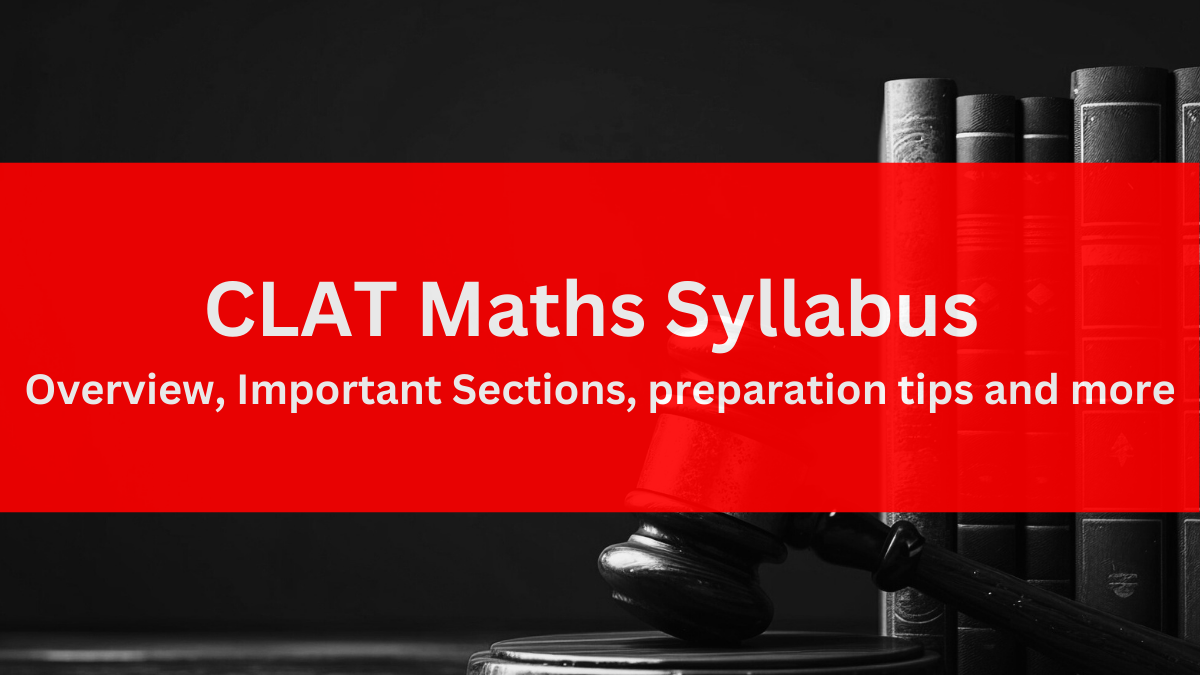CLAT Maths Syllabus 2025: Overview, Important Sections, preparation tips and more
CLAT Maths Syllabus 2025: The CLAT (Common Law Admission Test) 2025 presents a comprehensive examination for aspirants aiming to pursue undergraduate and postgraduate legal studies in India. Among its various sections, the Quantitative Reasoning segment holds significant importance, evaluating candidates’ ability to interpret and manipulate numerical data.

This section, while comprising only 10% of the overall exam weightage, is important due to its reliance on precise mathematical operations and factual information. The official CLAT Maths Syllabus 2025 includes various mathematical concepts such as basic arithmetic, ratios, algebra, measurement, and statistics. Understanding and effectively preparing for this section can greatly enhance your performance and overall exam score.
Get ready for the CLAT with our FREE MOCK TEST guided by our experts.
Official CLAT Maths Syllabus 2025
Understanding Numerical Information:
- Passages: Extracting relevant information from text-based numerical data.
- Graphs and Diagrams: Interpreting and analyzing data represented in graphical forms.
- Data Representations: Working with numerical information depicted through different formats, such as charts, tables, and diagrams.
Mathematical Operations and Concepts:
- Basic Arithmetic: Proficiency in fundamental operations such as addition, subtraction, multiplication, and division.
- Ratios and Proportions: Understanding and applying ratios and proportions in various contexts.
- Algebra: Utilizing algebraic expressions, equations, and inequalities.
- Measurement: Applying concepts of measurement in real-world scenarios.
- Statistics: Interpreting statistical data, including mean, median, mode, and standard deviation.
Know more: CLAT Exam 2025: Date, Registration, Eligibility, Pattern, Syllabus, Preparation Tips, Cut Off
CLAT Maths Syllabus 2025: Overview
| Particulars | UG-CLAT | CLAT LLM |
| Number of questions | 120 | 120 |
| Mode | Offline | Offline |
| Type of questions | Multiple choice with comprehension passages | Questions are presented in the format of multiple-choice accompanied by passages for comprehension. |
| Negative marking | -0.25 for each incorrect answer | Deduction of 0.25 marks for every wrong answer. |
| Skills tested | Reading ability, critical thinking, and analytical skills | The ability to read effectively, think critically, analyse situations, and comprehend the law. |
| Prior knowledge of law | Not required | LLB-level understanding is necessary. |
CLAT Maths Syllabus 2025 : Important Details
CLAT’s math section holds a 10% weightage but is crucial due to its factual answer options. Unlike general math, CLAT math poses questions from facts, conditions, data, graphs, or textual representations containing numerical info. Candidates must study the info before answering. Though processing such data takes time, the skills tested are basic math skills.
CLAT Maths Syllabus 2025
| Particulars | Important Details |
| Total Weightage | 10% |
| Type of Questions Asked | Sets of facts, graphs, or other representations, followed by questions. |
| Skills to be Tested | Derive, infer, and manipulate numerical info; apply 10th-standard math operations. |
| Key Topics | Percentage, Ratios, proportions, basic algebra, measurement, statistical estimation. |
| Standard of Questions | Class 10th |
| Marking scheme | Each correct answer will be awarded 1 mark each and 0.25 marks will be deducted for every incorrect answer. |
The syllabus is lengthy, and question papers require reading around 20-25 passages in 120 minutes. Practice with sample questions and previous papers is crucial.
Know more: CLAT Admission Process 2025: Documents Required And Procedure
Important Topics for CLAT Maths Syllabus 2025
| Mensuration | Areas, Volumes |
| Commercial Mathematics | Interest, Profit, loss and Discounts, Percentage, Partnership |
| Data Interpretation | Graphs, Charts |
| Arithmetic | Number system, H.C.F and L.C.M, Fractions, and decimals, Roots and Indices, Simplification, Ratio and proportions, Time and Work, Average |
CLAT Maths Syllabus 2025: How to Prepare for CLAT Maths Syllabus
Practice Makes Perfect
- Aim to solve at least 20 relevant questions daily.
- Initial Focus: For the first two months, concentrate on specific topics.
- Mixed Practice: In the final month, switch to practicing mixed topics.
- Timing: Regularly time yourself while solving problems. As you progress, aim to solve most questions within a minute.
Mocks and Analysis
- Practice and Evaluate: Regular practice is important, but evaluating yourself through mock tests is crucial.
- Understand the Pattern: Mock tests will help you familiarize yourself with the types of questions and patterns you’ll encounter.
- Identify Strengths and Weaknesses: Recognize and work on both your strong and weak areas. Avoid focusing solely on weaknesses; balance your preparation.
- Analyze Mocks: Pay attention to the time spent on each section, determine the fastest methods to solve questions, and identify topics that need more focus.
Learn the Formulas
- Formula Sheet: Create a formula sheet and review it daily.
- Memorization: While understanding concepts is key, memorizing essential formulas and tricks will help you solve problems more efficiently. Each topic has specific formulas and shortcuts that are crucial for saving time.
Other Helpful Tips
- Basic Calculations: Memorize multiplication tables up to 20, squares up to 30, and cubes up to 20. This knowledge will be useful for both math and logical reasoning sections.
- Application of Formulas: Understand and practice the variations in the application of formulas, especially in topics like mensuration.
- Time Management: Out of the 20 questions in the section, aim to solve at least 10 in under 1 minute. Identify these questions first to maximize your score.
- Time Limit: Don’t spend more than 15 minutes on the math section unless you’ve completed the other sections first.
Sign up for the CLAT Classroom live -online 2025 program is designed to efficiently build your overall skills in all the CLAT domains to help you crack the NLU cutoffs and the personal interviews.
Conclusion
CLAT Maths Syllabus 2025 of the CLAT UG 2025 exam requires candidates to demonstrate their proficiency in basic mathematical operations and their ability to interpret numerical data from diverse formats. To excel, it is essential to focus on fundamental concepts, practice regularly, and refine problem-solving skills.
A structured study plan, involving consistent practice, timed exercises, and mock tests, will prepare you for the mathematical challenges presented in the exam. By mastering the key topics outlined in the syllabus and employing strategic preparation techniques, you will enhance your analytical skills and improve your chances of achieving a high score in the CLAT 2025 exam.






